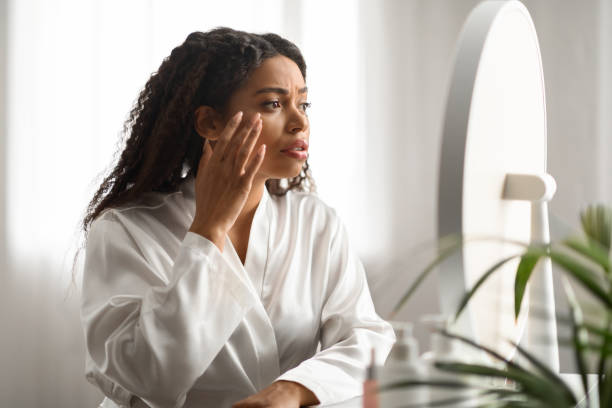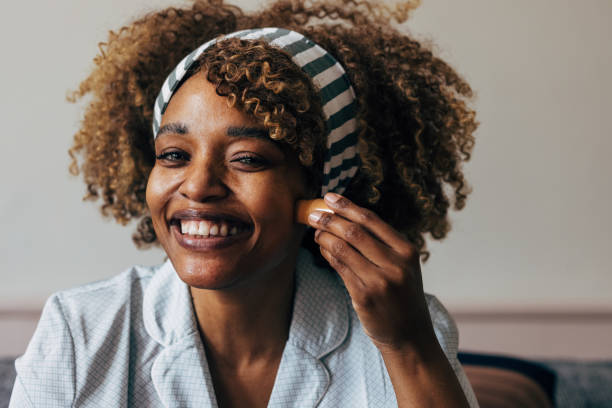What your skin need to be healthy in 2024?

Taking care of your skin goes beyond the use of skincare products. It also extends to self-care activities that can help you look out for yourself in the complete sense. Not only are such activities beneficial to help you loosen up and reduce your stress levels, but they will also provide a better look and feel to your skin. In this post, we will explore several things that you can incorporate into your skincare routine to help you achieve healthy, glowing skin. So sit back, relax, and get ready to understand how to take care of your skin from the inside out.
Understanding the skin:
Skin is not just a surface-level feature; it’s our body’s largest organ, diligently protecting us from the elements and keeping everything inside safe and sound.
1.Structure:

Our skin is like a multi-layered fortress, with each layer playing a crucial role in its overall function. The outermost layer, known as the epidermis, continually renews itself, while the dermis underneath provides support and elasticity.
It acts as a barrier to external polluants, and controls moisture; the dermis, containing hair follicles, sweat glands, and collagen—the protein that holds skin elasticity. Lastly, we have the subcutaneous layer, composed mostly of fat that acts to insulate the body. Knowing these layers and their role in skin health is vital for crafting a personalized skincare routine.
2.Function:
Your skin does much more than just look nice; it has loads of other vital functions. First off, it acts as a barrier, keeping your body safe from harmful UV rays—that’s right, you still need to give it a helping hand with sunscreen—bacteria, and pollution. It regulates body temperature through sweating and dilation of the blood vessels. Your skin has sensory receptors that allow you to feel touch, heat, and pain. It also produces vitamin D when it comes into contact with sunlight.
[poptin-form 756053c3d5d7b]
Recognizing signs of unhealthy skin?
When it comes to taking care of your skin, recognizing the signs of unhealthy ones is essential. Paying attention to these signs can help you address any issues and restore your skin’s natural glow.
1.Dull:
If your skin lacks radiance and appears lackluster, it might be a sign of unhealthy skin. Dullness can be caused by dead skin cell buildup, poor circulation, or external factors such as pollution and sun damage. Regular exfoliation in your skincare routine can help remove dead skin cells and leave you with a brighter complexion.
2.Dry:
Dryness is a common issue that occurs when your skin doesn’t retain enough moisture. It can leave your body feeling tight, rough, and sometimes even itchy or irritated. External factors like harsh weather, excessive cleansing, or a lack of hydration can contribute to dryness. To combat it, prioritize moisturizing products and use gentle cleansers that don’t strip away natural oils.

3.Rash:
Rashes can manifest as red, irritated patches and are often a result of inflammation or an allergic reaction. They can be caused by a range of factors, such as sensitivity to certain ingredients or environmental triggers, like pollen or dust. It’s essential to pay attention to any unusual changes in your skin and seek medical advice if needed. Avoiding potential irritants, using hypoallergenic products, and seeking medical advice if rashes persist are crucial steps to address this issue.
4.Acne:
Whether it’s occasional breakouts or persistent pimples, acne can take a toll on our confidence and skin health. It occurs when hair follicles become clogged with oil, dead skin cells, and bacteria. It can be characterized by whiteheads, blackheads, pimples, or even cysts. Hormonal changes, genetics, or certain skincare and lifestyle factors can contribute to acne. You need to tailored a proper cleansing routine, using non-comedogenic products, and considering targeted treatments can help manage acne-prone skin effectively.
By recognizing these signs, we can take proactive steps to address them and pave the way for a healthier, happier complexion.
Hydrate the right way
1. How to tell if your skin is dehydrated or dry?
One of the essential aspects of maintaining healthy skin is proper hydration. But how can you tell if you are dehydrated? Well, your body gives you some warning signs to indicate when it’s thirsty for water. Common symptoms of dehydration include dry mouth, increased thirst, fatigue, dark-colored urine, and even dizziness. Paying attention to these signs is crucial, as even mild dehydration can have an impact on your skin’s overall health and appearance. Studies have shown that dehydration can lead to increased dryness, flakiness, and a decrease elasticity. So, listen to your body and make sure you’re staying hydrated to keep your skin happy and healthy.

2. Use a water spray:
Using a water spray as part of your skincare routine might seem like a simple step, but it can have remarkable benefits for your skin’s hydration. They are known as facial mists, work by providing an instant burst of hydration. They can help replenish moisture levels, soothe irritated skin, and create a refreshing sensation. Additionally, they can enhance the penetration and absorption of other skincare products, such as serums and moisturizers. Studies have also demonstrated that using a water spray can increase hydration and improve the overall quality of the skin’s appearance. So, make sure to keep a water spray handy throughout the day, especially when feel that you needs that extra boost of hydration.

3. Eat more water, avoid dehydrated drinks:
Hydrating goes beyond just drinking water. It also involves consuming water-rich foods that can contribute to your overall hydration levels. Fruits and vegetables like watermelon, cucumbers, oranges, and lettuce have high water content, and incorporating them into your diet can help keep you hydrated from within. On the other hand, it’s essential to be aware of drinks that can dehydrate your body and, by extension, your skin. Beverages like alcohol and caffeinated drinks can have a diuretic effect, increasing urine production and potentially leading to dehydration. To maintain optimal hydration, aim to drink more plain water and herbal teas.
4. Use moisturizer:
Using a moisturizer is a crucial step. Moisturizers work by sealing in moisture and creating a protective barrier on the skin’s surface. They help prevent water loss, improve elasticity, and promote a smoother complexion. Mild studies have demonstrated the benefits of moisturizers in improving hydration and moisture retention. Look for moisturizers that contain hydrating ingredients such as hyaluronic acid, glycerin, and ceramides, as they effectively replenish and lock in moisture. Additionally, based on your skin type, choose a moisturizer that suits your specific needs, whether that’s lightweight for oily ones or richer formulations for dry ones.
[poptin-form 756053c3d5d7b]
How your gut gets in the mix?
1.What about my gut health?
Ever heard the phrase, ‘you are what you eat’? Well, it’s not just a statement, but a scientific fact; it’s one that top dermatologists like Dr. Lisa Johnson and nutritionists like Sarah Miller have come to uphold. Dermatologist Dr. Lisa Johnson, who is well-versed in skin health research and practice, and nutritionist Sarah Miller, who has a special interest in skin health, have both illuminated the level at which gut health impacts the skin. Research by Dr. Johnson and her colleagues at Skin Health Institute has unraveled the complex connection between the gut and skin. They have found that the guts need a balanced, thriving microbiome for a healthy skin environment. Now, the gut microbiome is the community of trillions of microorganisms which influence multiple physiological functions: from inflammation, immune response, and hormonal balances, all of which play a major role in the health of the skin.

2. How to get an healthy gut?
Sarah Miller holds more than two decades of experience in the field of nutritional science and corroborates the sentiments that Dr. Johnson shared. Her studies have demonstrated that specific foods, such as probiotic yogurts, fruits and vegetables full of fiber, and fish high in omega-3 fatty acids, can be used to support a good gut microbiome, and in turn, skin disorders such as acne, eczema, and premature aging are improved.
The relationship of the gut to skin, as illuminated by Dr. Johnson and Miller, brings out the need for the adoption of a holistic perspective towards skincare. By consuming foods recommended by Miller and following dietary tips prescribed by Dr. Johnson, you can take the right foods to nourish your gut microbiome and, thus, create a brighter, clearer, and more resilient skin.
But it’s not just what you eat—how you eat matters, too. The more you are able to chew your food slowly and savor your bites, the better your body will be able to digest it. Try to avoid eating on the go or while you’re in a state of stress. Stress can wreak havoc on your gut health, so try to take a few minutes for deep breathing or meditation each day.
Do you really need exercise?
1. Benefits of exercising:
Exercise isn’t just good for the body—it’s great for the skin too! When you work up a sweat, you’re not just burning calories; you’re also flushing out toxins from your pores, giving them a natural detox. Plus, increased blood flow delivers oxygen and nutrients, promoting a brighter, more youthful complexion.

2. Best types of exercises:
So, what are the best workouts for that post-gym glow? Cardiovascular exercises like running, cycling, and swimming get your heart pumping and your blood flowing, making them excellent choices. Strength training exercises like weightlifting also stimulate collagen production, helping to keep away wrinkles.
But don’t forget about yoga and Pilates! These low-impact exercises not only improve flexibility and strength but also reduce stress levels, which can have a positive impact. And let’s not overlook the power of a good old-fashioned walk in the fresh air—simple yet effective!

3. Indirect effects:
Beyond the direct benefits, regular exercise can work wonders for your overall well-being, indirectly improving your skin’s appearance. From reducing stress and improving sleep to boosting confidence and mood, the positive effects of exercise ripple throughout your entire body, reflecting in a radiant, healthy complexion.
What self-care has to do with it?
Now that we’ve explored the various facets of self-care and their impact on skin health, it’s clear that nurturing it goes beyond skincare products and beauty routines—it’s about adopting a holistic approach to self-care.
By understanding is structure and function, recognizing signs of problem, and addressing them through hydration, healthy eating, exercise, and more, we can cultivate a radiant complexion from the inside out.

Self-care isn’t just about pampering ourselves; it’s about prioritizing our physical, mental, and emotional well-being. When we take the time to nourish our bodies with hydration, nutritious foods, and regular exercise, we’re not only supporting our overall health but also promoting a clear, luminous complexion.
So let’s make self-care a non-negotiable part of our daily routine. Whether it’s indulging in a skincare ritual, sipping on a hydrating green smoothie, hitting the yoga mat, or simply taking a moment to breathe deeply and relax, every act of self-care brings us one step closer to glowing skin and a healthier, happier life.
Share this post if you liked it
[DISPLAY_ULTIMATE_SOCIAL_ICONS]



0 commentaire